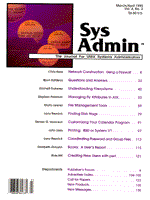
Sidebar: Other Filesystems
While the primary two filesystems in UNIX are S5 and UFS, with NFS and RFS handling networked partitions, a number of other filesystems are cropping up from vendors. These include: BFS -- Boot File System contains only the utilities necessary to bring a system up and into operation. Usually used after a crash, it brings up a simple flat filesystem with one directory. DTFS -- Desk Top File System is a new entry planned by SCO for release in the summer. Currently, SCO offers the Acer Fast Filesystem (AFS) and Extended Acer Fast Filesystem (EAFS). AFS roughly corresponds to S5 and limits filenames to 14 characters in length. EAFS corresponds to UFS, enabling character names up to 255 characters in length. DTFS will include compression and some undelete features, and is aimed at the small disk market, where every byte saved is a byte earned. HTFS -- High Throughput File System, another new filesystem expected to be released by SCO in the summer, will implement journaling. Journaling involves maintaining a record of changes, rather than actually making the changes when they are requested. When the system slows down, or at designated intervals, the journal writes all the pending changes to the disk. An added benefit is that journaling allows you to keep a record of changes, and even back them out, reverting to previous versions of the file. VFS -- Virtual File System, created by Sun Microsystems as an outgrowth of NFS, provides an interface between the kernel and inode operations independent of the filesystem running. Such independence means that it matters not whether S5 or UFS is the underlying filesystem, since that is completely hidden from the end user and all applications. An interface rather than a filesystem, VFS allows a number of different filesystems to interact with the kernel. FFS (File System Switch) was a similar attempt by AT&T, but it failed to gain any acceptance in the marketplace.
|